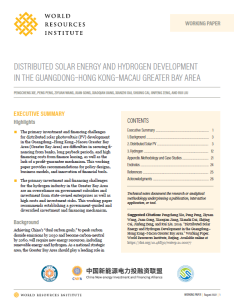Distributed Solar Energy and Hydrogen Development in the Guangdong–Hong Kong–Macau Greater Bay Area
The working paper begins by providing an overview of the current state of development and future potential of distributed solar PV and hydrogen in the Guangdong–Hong Kong– Macao Greater Bay Area. It proceeds to analyze the challenges for investing and financing, then closes with relevant recommendations.
New energy resources such as renewable energy and hydrogen play an important role in China’s efforts to reach its “dual carbon goals.” By 2030, solar and wind power installations must reach 1.2 terawatts (TW), more than double the 534 gigawatt (GW) capacity in 2020. By 2060, nonfossil fuels must account for over 80 percent of total primary energy consumption. Forecasts by research organizations indicate that by 2030, solar energy will make up two-thirds of all new wind and solar installations; while by 2060, solar installations will reach 2.6 TW.2 In terms of hydrogen, the China Hydrogen Alliance predicts that by 2030, the gross domestic product (GDP) generated by China’s hydrogen industry will reach RMB 1 trillion and demand for hydrogen will reach 37 million tonnes. By 2050, hydrogen will contribute more than 10 percent of China’s total end use energy consumption and the annual GDP of the hydrogen industry will reach RMB 12 trillion.
As part of China’s national development strategy, the Greater Bay Area should serve as a driving force in high-quality development and pioneer a comprehensive transition to a greener society. We have chosen to analyze distributed solar PV and hydrogen in the Greater Bay Area and, more specifically, how solar developments can take advantage of China’s new policy of promoting distributed PV technology throughout selected counties. Also, Guangdong Province has a fully developed hydrogen industry chain that includes production, storage and transportation, hydrogen refueling stations, and hydrogen fuel cells, as well as hydrogen vehicle design and production. This foundation has made the Greater Bay Area China’s fastest-developing region for hydrogen. This working paper begins by providing an overview of the current state of development and future potential of distributed solar PV and hydrogen in the Guangdong–Hong Kong– Macao Greater Bay Area. It proceeds to analyze the challenges for investing and financing, then closes with relevant recommendations.
